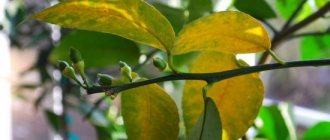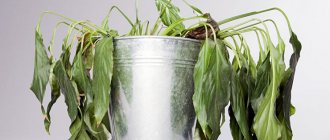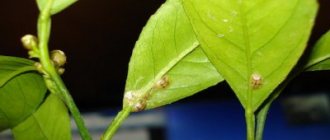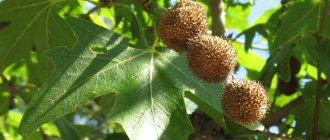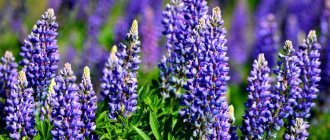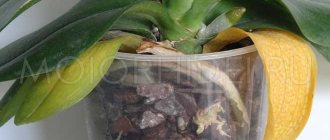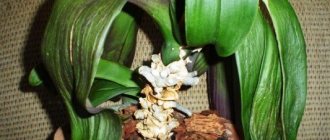Causes of homemade lemon diseases
Various diseases negatively affect the appearance of the plant and fruiting. Lemons are most often affected by diseases and pests:
- weakened by other diseases;
- for which proper care has not been established (watering, pruning);
Indoor lemon
- kept in unsuitable conditions (improper lighting, drafts, poor soil, poor temperature conditions).
Viruses, bacteria or pests may appear:
- from poorly treated soil,
- from a diseased cutting when grafting,
- while airing the room (happens extremely rarely),
- from sick indoor plants nearby.
Many lemon diseases can be cured, but there are also diseases that cannot be cured and the plant must be disposed of.
Types of disease
There are many types of leaf chlorosis, the difference of which is reflected in the lack of a certain element in the plant’s nutrition. To determine which microelement is missing, you should focus on external signs.
- Iron chlorosis. The most common type of chlorosis with identified iron deficiency. Characterized by yellowing of the leaf blade. The color of the veins remains rich and bright. Young shoots are affected first. The cause of this disease can be calcareous soil.
- Magnesium chlorosis occurs when there is insufficient magnesium, for example due to sandy soil. The disease manifests itself in the same way as with a lack of iron, but it is not the young leaves that suffer first, but the mature ones. The symptoms in this case are similar to mosaic disease. The leaves gradually begin to change color. The edges are affected first, then the entire plate. Greens often take on an orange or red hue.
- Sulfur chlorosis can appear from a lack of sulfur in the diet. In this case, the veins of the leaves turn yellow or white. Then the color of the entire leaf changes.
- Nitrogen chlorosis. The first signs are whitened veins of the lower leaves. Further, discoloration gradually covers the entire leaf plate, starting from the middle. The lower leaves wither and fall off. A lack of nitrogen can be caused by excessive ash application or increased acidity. The reason may be the introduction of organic matter into the soil that has not yet decomposed.
- Zinc chlorosis. This disease appears as spots, first spreading on the lower row of leaves. Most often, the plant is susceptible to disease in the spring due to excess nitrogen in the soil.
- Calcium chlorosis causes plant growth to stop, flowers, buds and ovaries to fall off. “Tip rot” appears on tomatoes in the form of round necrotic spots.
Why do lemon leaves turn yellow?
Gooseberry diseases and their treatment
The leaves of indoor lemons turn yellow because:
- Incorrect lighting was chosen (direct rays of the sun provoke the appearance of burns, excessive shading, especially in the cold season, does not allow the plant to fully develop).
Lemon with yellowing leaves - Insufficient or excessive watering, which are equally dangerous for lemon.
- Violation of the usual temperature regime causes stress in the plant, which leads to negative consequences. Lemons develop well in the temperature range of 14-25 C0, but 20 C0 is ideal for them. During ventilation (especially in autumn or winter), it is recommended to remove the lemon from the room to avoid sudden temperature changes. Central heating radiators or other heating devices should not be in the immediate vicinity of the pot.
- Increased or decreased level of humidity in the room (optimally from 60% to 70%).
- Irrational or irregular feeding. Lemon needs nutrients, but too much of them is not good for your pet.
Lack of water
But you shouldn’t skimp on water for watering lemons either - a shortage doesn’t lead to anything good either. The leaves of a tree growing in dry soil also begin to turn yellow, curl, and fall off. The consequences of a lack of life-giving moisture are still the same - small roots die off, and the plant cannot absorb the substances necessary for life from the soil. Which puts the lemon in a stressful state and slows down the circulation of juices through the tissues of the plant. As a result, there is nothing to feed the shoots and foliage growing from above, so you have to discard part of the crown. When trying to bring a lemon that has not been watered for a long time back to life, you cannot immediately start flooding the soil. Because excess water (this has already been discussed) destroys the roots of the plant no less than lack of moisture.
Lemon leaf chlorosis
Diseases of clematis and their treatment - what causes flowers
Plant chlorosis is a disruption of the process of chlorophyll formation in leaves. The main sign of the disease is yellowed leaf blades and green veins.
Leaf chlorosis
The main cause of the disease is a lack of iron and magnesium.
Ways to combat chlorosis:
- Transplanting the plant into new soil and a larger pot;
- Spraying the leaves with Ferovit solution (1.5 ml per 1 liter of water);
- Fertilizing with magnesium sulfate;
- Washing the soil in the pot (water the lemon with warm water for 30 minutes until clear liquid flows out of the drainage holes). This improves the soil structure and its breathability. 30 days after the procedure, the plant is fed.
How to disguise ribbing?
As a temporary solution to the problem, special medicinal compounds are used to level the ribbed surface of the plate.
They are applied under varnish instead of a base coat. Which remedy is right for you and whether it is safe to use, you need to check with your podiatrist. Among decorative varnishes, varnishes with mother-of-pearl or sparkles will better hide a cosmetic defect, while plain glossy coatings, on the contrary, will emphasize unevenness. Under no circumstances should you try to level the surface of the plate with a sanding file, as the nail will become thinner and more vulnerable. It is also not recommended to do extensions or use gel polish until the nail has recovered.
Why do lemon leaves curl?
One of the common diseases of homemade lemons is leaf curl.
Phlox diseases and their treatment: why leaves curl
Causes of the disease:
- 1) Violation of the rules of care (most often improper moistening of the soil and air).
- 2) Lack of mineral fertilizers (deficiency of calcium, boron or copper in the soil).
- 3) Lack of fresh air.
- 4) Damage to the plant by various pests (both on the crown of the tree and on the root system).
Important! Mineral fertilizers are applied very carefully, since their overdose has a negative effect on the plant.
Watering
Have your lemon leaves started to curl into a tube at the ends and then turn yellow? The reason is probably due to insufficient watering of the plant. It is best not to let the lemon soil dry out, as this can lead to drying out and death of the plant. The soil in the pot should always be slightly damp. But if the soil does dry out, it needs to be moistened gradually, with small portions of water at intervals of several hours. Sharp watering of a lemon after a “drought” can negatively affect the plant, and it will shed its leaves.
This is what happens if you don’t water the lemon for a long time and the soil dries out. Too much watering will also not have the best effect on the condition of the plant. When there is a large accumulation of moisture in the soil, the leaves turn yellow at their base, and not at the tips. Flooding the plant adversely affects the condition of the root system, it begins to rot, and because of this the plant begins to ache and wither.
Causes of lemon leaves falling off
The question “why does a lemon drop its leaves, what should I do” worries many plant growers. A common cause of homemade lemons dropping leaves is some kind of viral or fungal disease:
- Leaf mosaic (leaves change their shape, dark or light strokes appear on them, reminiscent of a mosaic, the plant stops growing). It is impossible to treat a diseased lemongrass; you can only prolong the life of the plant by regularly feeding and properly caring for it. Experts recommend destroying such a lemon so that the disease does not spread to other plants.
- Cancer of citrus plants (in the initial stages, the leaves and fruits become covered with brown spots, later the lemongrass takes on ugly shapes, the foliage falls off, and the tree dies). It will not be possible to revive a diseased tree, but to prevent cancer, it is recommended to spray the lemon with liquid copper fungicides.
- Tristeza (one of the reasons why a lemon sheds its leaves; in addition, the branches and bark gradually die off, and the tree dies). The disease is incurable and most often affects weakened plants.
- Anthracnose (leaves turn yellow and fall off, thin branches die, the tree may drop its buds, red spots appear on the fruits). Treatment: cut off dried branches, treat the plant three times with Fitosporin, a 1% solution of Bordeaux mixture is also suitable.
- Malsecco (leaves fall off, shoots from the tops begin to dry out, branches turn red when cut). The cause is a lack of lighting; from October to April, the plant needs lighting to increase daylight hours. Treatment with drugs is impossible. If normalizing the light regime does not help, then the plant should be disposed of.
- If affected by root rot, the lemon may also shed its leaves. If for this reason the leaves of a lemon fall off, then you know what to do: dig up the plant, wash and inspect the root system, and remove rotten roots. The lemon is planted in another pot in disinfected soil. For 12-14 days, do not water the plant, but only spray it with warm water and wipe the leaves with a damp sponge.
Preventive measures
For proper growth, lemons need good lighting throughout the year. This is especially true for adult plants, which bear fruit almost without interruption. In the summer, when placing a lemon near southwestern and southern windows, bright daylight is usually enough for it, but on cloudy days it is necessary to turn on the backlight.
In winter, in order to avoid yellowing of the leaves, it is necessary to provide additional illumination to a full daylight hours of 12 hours.
It is important to monitor watering and the condition of the soil in the pot, and also not to forget about frequent spraying. It is necessary to protect the lemon from overheating and hypothermia, from direct sunlight and drafts. Only providing the right conditions will help maintain the health and beauty of the plant, prevent yellowing and falling leaves, and ensure stable fruiting.
Sticky coating on lemon leaves
Sticky plaque not only spoils the appearance of the tree, but also inhibits its development.
Sticky spots on leaves
Reasons for the appearance of a sticky layer:
- inadequate care;
- excessive watering for a long time;
- the plant was attacked by scale insects;
- Aphids appeared on the lemon.
The first 2 factors are easily eliminated after studying the relevant information on proper plant care. Scale insects and aphids are pests that are difficult to control, but quite possible.
Note! Sticky golden resin on reddish-brown spots and cracks on the trunk and branches of a tree is a sign of homosis, the causes of which lie in a lack of potassium and phosphorus, an overdose of nitrogen or poor soil.
Symptoms of erysipelas
The disease begins abruptly and is acute. Patients, as a rule, can even indicate the hour of its occurrence.
The onset is similar to a severe acute respiratory viral infection - the temperature rises quickly, and general intoxication of the body occurs. Chills (often shaking), headaches, nausea, vomiting, pain and aches in the back and joints are observed. In severe cases, convulsions and delirium may occur.
Skin lesions begin to develop 10-20 hours after the onset of general symptoms. It begins with itching of the skin, a feeling of tightness, and sweating. Then the skin at the site of infection begins to redden and swell, and severe erythema occurs.
A characteristic sign of erysipelas is very bright hyperemia (redness) of the affected area with clear, uneven boundaries, which are called “tongues of flame” or “geographic map.” The edges of the area are raised in the form of an infiltration ridge. The inflamed area is hot to the touch, swollen, thickened, and shiny. When pressing on it, slight pain occurs; after pressing, the redness under these areas disappears for a few seconds.
Lymphadenitis is also characteristic - hardening of the lymph nodes, decreased mobility and pain when pressed. In some patients, a pink stripe appears on the skin, which connects the inflamed area with the nearest group of lymph nodes.
Fighting yellow spots on lemon leaves
Lack of lighting, low air humidity, inadequate watering, sudden temperature changes and poor nutrition can cause yellow spots to appear on the leaves of homemade lemons. The same symptoms can be observed in some diseases:
- Scab or wart is a fungal infection of a plant, the main symptom of which is yellow spots on the leaves, gradually degenerating into pink-gray warts (growths). Orange spots appear on the fruits. Warts gradually spread throughout the plant, destroy the fruits, and can lead to the death of the tree. Treatment: treatment of the crown with a 1% solution of Bordeaux mixture, removal of affected branches, fruits and leaves.
- Infection with dark brown spot (the appearance of irregularly shaped yellow spots on leaves) is incurable. The diseased plant must be destroyed to avoid spreading the disease to others.
- With phyllostictosis, brown specks with rims appear on the lower leaves.
- Late blight is characterized by swelling of the bark and oily spots on the foliage.
Phyllosticosis and late blight can be cured with fungicidal drugs.
Lack and excess of fertilizers
Citrus fruits are quite demanding regarding the presence of nutrients and microelements in the soil. If small yellow spots appear on the leaves between the veins, then it’s time to feed the lemon, otherwise the plant will die. Specialized fertilizers for citrus fruits are ideal for feeding. Although you can balance your diet yourself.
But keep in mind that in addition to phosphorus and nitrogen, your pet will also need preparations with magnesium, iron, zinc, potassium, calcium, and sulfur. So if you are not a fanatic gardener, then it is better to buy ready-made fertilizer. An overdose of fertilizers can cause all the leaves to fall off at once. Don’t forget, if you want to calmly enjoy the fruits without risking your health, adhere to measures in the use of fertilizers.
Drying tips of leaves and white spots on them
The tips of the leaves may dry out when:
- unsuitable microclimate;
- unbalanced lighting;
- mineral starvation;
- incorrectly selected soil for planting;
- infection by parasites.
Lemon leaves covered with a white coating indicate the appearance of a whitefly butterfly.
Whitefly butterfly
Detecting a parasite is easy:
- after shaking the branches, the butterflies take off;
- grayish-white formations resembling mold appear on the leaves and shoots;
- affected leaves curl, turn yellow and dry out.
Ways to control insects:
- a few butterflies are destroyed by washing the leaves with gauze soaked in a soap solution;
- Sticky fly strips are hung near the tree;
- spray the plant several times with a sweet solution (2 tablespoons of sugar dissolved in a glass of water);
- a large number of insects can only be defeated with the help of special chemicals.
Why doesn't lemon bear fruit?
Not all lemon trees bear fruit. For many owners, this is simply a beautiful decorative decoration for their home. Why lemon does not bear fruit, the main reasons:
- 1) the plant grew from a seed and was not grafted;
- 2) the tree is not grafted correctly;
- 3) violation of comfortable living conditions (temperature changes and low humidity);
lemon blossom - 4) there are too many flowers and fruits on the tree (experts advise removing excess ovaries, following the rule: “10 leaves - 1 flower”);
- 5) untimely fertilizing (forces the lemon to lose color);
- 6) the plant is sick or infected with parasites.
What to do to make fruit appear on a lemon:
- Provide appropriate conditions for full growth and development.
- Fertilize regularly (in spring and summer 2 times a month, in autumn and winter - monthly).
- Graft the plant correctly (graft a strong tree whose bark is well separated from the wood). For the operation, use a clean and very sharp knife. To achieve the best possible alignment of the branch and petiole, the grafting site is tied tightly and tightly. The result will be judged after 3 weeks.
- Cure diseases and get rid of pests.
- Form the crown so that by the age of three it consists of 7 main branches (at the same time, try not to constantly shorten the tips of thin branches, since it is on them that flowers appear).
- The procedure of tightening the branches is carried out. To do this, in the spring they are tied together with soft wire to concentrate nutritional reserves in them for the next year.
Important! Under optimal conditions, the lemon will bloom 2-3 years after grafting.
Prevention
To prevent plant disease, certain measures should be taken. This concerns proper planting preparation and optimal timely care of the crop. To implement the necessary measures, it is important to know the types of chlorosis. This disease occurs:
- non-infectious, associated with a lack of certain types of microelements. If it is not possible to determine which element is insufficient in the crop, complex ready-made fertilizers with a balanced combination of microelements should be used. Such drugs include “Zdraven”, “Uniflor Micro”, “Florist Micro”.
- infectious. In this case, special attention should be paid to disinfection. This applies to seeds, soil, tools. Before planting the crop in the soil, it is advisable to add biofungicides as a preventive measure. They are also used to treat planting material to increase stability.
Lemon pests at home
Lemons, like other house plants, are attacked by various pests.
Description of signs of spider mite infestation:
- 1) yellow dots appear;
- 2) yellowing of the edges of the leaves begins,
- 3) the leaves roll into tubes,
- 4) cobwebs or cobweb nests appear in the leaf tubes.
Spider mite infestation
The parasite feeds on lemon juice, is very small and invisible to the naked eye, but causes enormous damage. Home and folk remedies are ineffective; they not only do not destroy the pest, but also allow it to live and reproduce unhindered. You can fight spider mites only with insecticidal preparations, for example, Fitoverm, Actellik and Demitan.
Signs of aphid infestation:
- leaf plates and young shoots are deformed;
- a sticky coating appears;
- on the back of the leaves you can see colonies of small green pests (adults turn black).
Aphids usually appear in the spring; insects use their proboscis to suck juice from leaves and young shoots. The parasites are very prolific: about 20 generations can grow in a season.
Aphids on a lemon branch
Among the traditional methods, treating the plant with an infusion of wood ash mixed with a strong soap solution is effective.
Mechanical removal of parasites brings a temporary effect, after which the insects resume their population.
Among chemical preparations, experts recommend using Fitoverm or Iskra Zolotoy.
Scale insects are one of the most difficult to eradicate pests that attack indoor lemons. Signs of scale insects appearing on a tree:
- the appearance of yellowish or reddish-brown spots on the leaves;
- the appearance of plaque along the veins on the leaves;
- the formation of a sticky liquid on the leaves (in some cases, the parasites produce such an amount of liquid that it accumulates at the ends of the leaves);
- movement of adults along leaves and trunk.
You can remove the parasite mechanically (wipe the leaves with a cloth soaked in a strong soap solution or alcohol); this is effective, but labor-intensive. In addition, there is always a risk of missing an adult parasite.
Scale insects on leaves
The most effective chemicals for combating scale insects are Aktara and Actellik, which have a systemic effect. They are not only sprayed onto the crown of the plant, but also watered with it. This allows you to influence parasites through their digestive tract, and not just through contact.
Thus, homemade lemons are subject to a large number of diseases and pests. Some diseases of indoor lemon lead to the death of the plant, so experts recommend not neglecting the rules of caring for the tree and preventing the occurrence of various ailments.
Natural remedies for constipation
There are a number of different ways to soften stool naturally, including dietary changes, physical activity and nutritional supplements. These include:
Cellulose
Most plant foods contain fiber (fiber). There are two types of fibers: soluble and insoluble.
Insoluble fibers are most useful for softening stool. They do not dissolve in water and help food pass from the stomach to the intestines faster.
Whole grain flour, nuts, beans and vegetables such as cauliflower, green beans and potatoes contain insoluble fiber.
It is necessary to gradually increase your fiber intake and drink more water, which helps smooth the passage of fiber through the digestive tract.
Research has shown that psyllium husk and wheat bran increase the water content of stool, which has a softening effect on the stool. Finely ground wheat bran had the opposite effect and reduced the water content of the stool.
Physical exercise
The active state has many health benefits, including improved intestinal motility. Movement helps stimulate the digestive system. Research has shown that exercise is an effective treatment for people with constipation.
Activity increases your body's need for water, so it's important to drink plenty before, during, and after exercise to keep your stool soft. For people who find it difficult to exercise, there are many easy workout options
These include yoga exercises specifically aimed at improving digestion. Pregnant women can also benefit from yoga tailored to their specific needs.
Probiotics
Probiotics are live, beneficial bacteria found naturally in fermented foods, including kefir, sauerkraut, yogurt, kimchi, miso, kombucha and tempeh. They are also available in supplements and yogurt-type drinks.
Probiotics help maintain the gut microbiome—the collection of trillions of microbes in the gut that keep the body healthy and balanced. Consuming probiotics increases the number of beneficial bacteria in the gut and improves digestion.
Studies have shown that taking probiotics helps soften stools and increase the frequency of bowel movements. Probiotics are safe for most people, including children, women who are pregnant or breastfeeding, and older adults. But before consuming them, you should consult a doctor or nutritionist.
Olive oil
The fats in olive oil help relieve constipation in two ways:
- smoothing the inside of the intestines, making it easier to pass stool,
- helping to retain more water, making stools softer.
One tablespoon of olive oil taken on an empty stomach can relieve constipation in most adults. Doctors do not recommend giving olive oil to children.
A study of 50 people with constipation found that olive oil, flaxseed oil and mineral oil were equally effective in relieving constipation symptoms in people undergoing dialysis.
Aloe vera
Aloe vera juice is obtained from the leaves of the plant. Aloe leaves are rich in compounds that help relieve inflammation of the digestive tract. To soften stool, a person can consume aloe vera juice by adding it to smoothies and juices or drinking it on its own.
Doctors do not recommend drinking aloe vera juice during pregnancy or while breastfeeding. Doctors also do not recommend it for children under 12 months of age. Some people may be allergic to aloe vera. Before drinking the juice, apply a small amount of aloe vera to the inside of your forearm. If no reaction occurs within 24 hours, then it is safe to try the juice.
Epsom salt
Epsom salt looks like table salt but contains minerals such as magnesium and sulfate. Epsom salts are often added to bath water to soothe aching muscles, but can also be taken orally as a natural treatment for constipation. Salt increases the amount of water in the intestines and softens the stool.
A study of 106 people with functional constipation found that drinking magnesium sulfate-rich mineral water daily improved stool frequency and consistency.
Doctors don't recommend Epsom salts for children under 6 and don't know if it's safe for pregnant or breastfeeding women, so they might want to avoid trying it.

